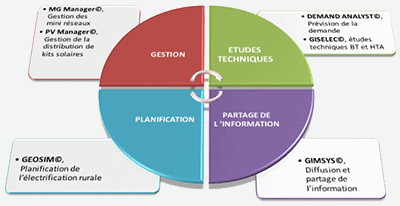ANALYSIS AND STRATEGIC PLANNING
IED offers both professional tools, training and skills training courses, integrated into projects or organized independently, for the various actors of the sector: ministries in charge of energy, rural electrification agencies, electricity companies, research departments, engineering schools, independent consultants, electrical system operators, private consulting firms ...

NAP is a complete software that allows the user to easily manage data manipulations, network graphs, reports, scenario management, and more.
The NAP program is a software designed to analyze and simulate the behavior of an electrical network. It includes the evaluation of the following indicators:
- Load Flow,
- Load flow with constraints,
- Optimized charge flow,
as well as the following calculation modules:
- Short circuit analysis,
- Simple incident analysis (Contingency),
- Sensitivity analysis,
- Dynamic stability analysis (Stability).
GAP is a software for analysis and planning of hydroelectric generation systems, thermal with wind farms and solar and energy storage. At the heart of the GAP lies a stochastic model of generation simulation, calculating the technical and economic results of different generation park expansion scenarios.
DAP is a software designed both to forecast the demand and the peak load, and to prepare actions of Demand Side Management (DSM). DAP has four modules: Simple Trend Forecast, Sector Trend Forecast, Customer Trend Forecast, DSM Forecast.
Developed with the support of National Societies of international importance (RTE, EDF ...), the calculations, results and methodologies have been tested and standardized. Marketed both in the private sector (design office ...) and for public institutions (Ministries, Rural Electrification Agency, national companies), these software products benefit from more than 30 years of experiences from around the world and sold in more than 30 countries.
These tools are used in national master plans, distribution, transport production, but also at regional or local scales, with the development of international interconnections and that of energy production by solar or wind injection.
The combination of DAP, GAP and NAP as a fully integrated plateform may also participate to several key strategic tasks such as:
- Contribution of Variable Renewable Energy (VRE) to firm capacity
- Performing probabilistic analysis of system generation with and without VRE
- Validating that long-term capacity mix meets short-term flexibility requirements and assessing flexibility costs
- Contribution of storage and demand response
- Future generation dispatch scenarios
- Co-optimising generation and transmission planning
- Grid integration studies on long-term VRE capacity scenarios, to assess and feedback the costs of stability solutions
This set of software, developed historically by Systems Europe and taken over by IED in 2016, is complemented by GEOSIM, developped by IED in 2005, a tool for the rural electrification of geospatial planning, pioneering and unique in the field of decentralized electrification or network extension by its computing power and its algorithms of computation at least cost.





